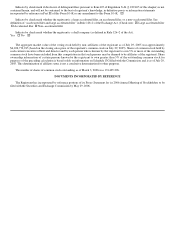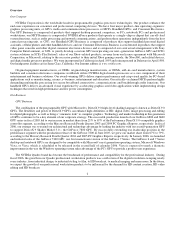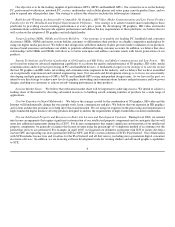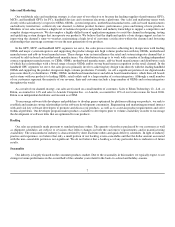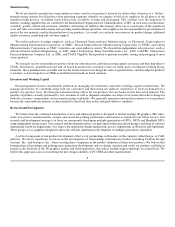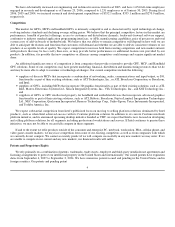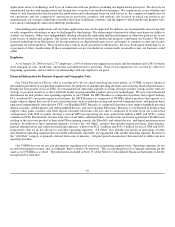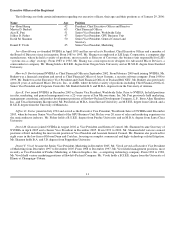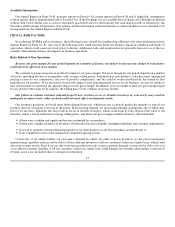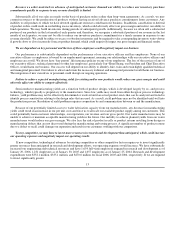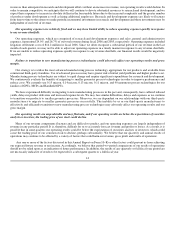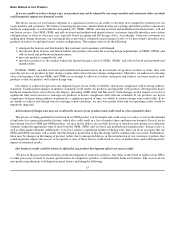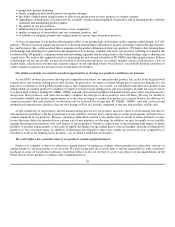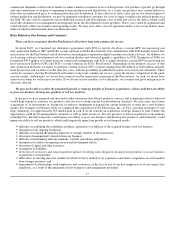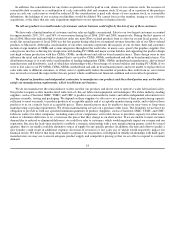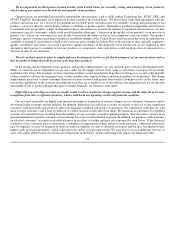NVIDIA 2006 Annual Report Download - page 15
Download and view the complete annual report
Please find page 15 of the 2006 NVIDIA annual report below. You can navigate through the pages in the report by either clicking on the pages listed below, or by using the keyword search tool below to find specific information within the annual report.
We have substantially increased our engineering and technical resources from fiscal 2005, and have 1,654 full−time employees
engaged in research and development as of January 29, 2006, compared to 1,231 employees as of January 30, 2005. During fiscal
2006, 2005 and 2004, we incurred research and development expenditures of $352.1 million, $335.1 million and $270.0 million,
respectively.
Competition
The market for GPUs, MCPs and handheld GPUs is intensely competitive and is characterized by rapid technological change,
evolving industry standards and declining average selling prices. We believe that the principal competitive factors in this market are
performance, breadth of product offerings, access to customers and distribution channels, backward−forward software support,
conformity to industry standard application programming interfaces, or APIs, manufacturing capabilities, price of processors and total
system costs of add−in boards or motherboards. We believe that our ability to remain competitive will depend on how well we are
able to anticipate the features and functions that customers will demand and whether we are able to deliver consistent volumes of our
products at acceptable levels of quality. We expect competition to increase both from existing competitors and new market entrants
with products that may be less costly than ours, or may provide better performance or additional features not provided by our
products. In addition, it is possible that new competitors or alliances among competitors could emerge and acquire significant market
share.
An additional significant source of competition is from companies that provide or intend to provide GPU, MCP, and Handheld
GPU solutions. Some of our competitors may have greater marketing, financial, distribution and manufacturing resources than we do
and may be more able to adapt to customer or technological changes. Our current competitors include the following:
• suppliers of discrete MCPs that incorporate a combination of networking, audio, communications and input/output, or I/O,
functionality as part of their existing solutions, such as ATI Technologies, Inc., or ATI, Broadcom Corporation, or Broadcom,
and Intel;
• suppliers of GPUs, including MCPs that incorporate 3D graphics functionality as part of their existing solutions, such as ATI,
Intel, Matrox Electronics Systems Ltd., Silicon Integrated Systems, Inc., VIA Technologies, Inc., and XGI Technology Inc.;
and
• suppliers of GPUs or GPU intellectual property for handheld and embedded devices that incorporate advanced graphics
functionality as part of their existing solutions, such as ATI, Bitboys, Broadcom, Fujitsu Limited, Imagination Technologies
Ltd., NEC Corporation, Qualcomm Incorporated, Renesas Technology Corp., Seiko−Epson, Texas Instruments Incorporated,
and Toshiba America, Inc.
We expect substantial competition from Intel's publicized focus on moving to selling platform solutions dominated by Intel
products, such as when Intel achieved success with its Centrino platform solution. In addition to its current Centrino notebook
platform initiative, and its announced upcoming desktop initiative branded as VIIV, we expect that Intel is now focused on developing
and selling platform solutions for all segments including professional workstations and servers. If Intel continues to pursue these
initiatives, we may not be able to successfully compete in these segments.
If and to the extent we offer products outside of the consumer and enterprise PC, notebook, workstation, PDA, cellular phone, and
video game console markets, we may face competition from some of our existing competitors as well as from companies with which
we currently do not compete. We cannot accurately predict if we will compete successfully in any new markets we may enter. If we
are unable to compete in our current and any new markets, our financial results will suffer.
Patents and Proprietary Rights
We rely primarily on a combination of patents, trademarks, trade secrets, employee and third−party nondisclosure agreements and
licensing arrangements to protect our intellectual property in the United States and internationally. Our issued patents have expiration
dates from September 4, 2007 to September 2, 2024. We have numerous patents issued and pending in the United States and in
foreign countries. Our patents and pending patent
9


